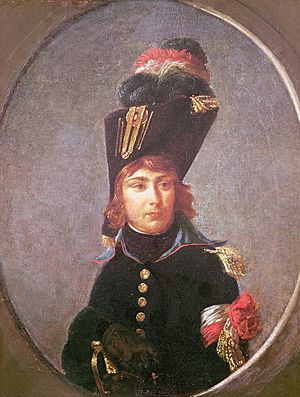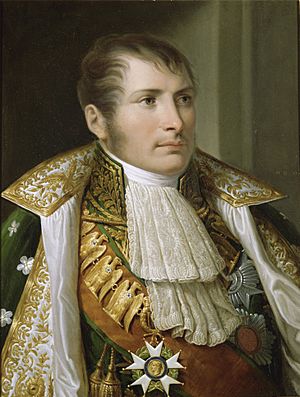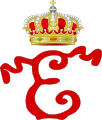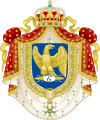Eugène de Beauharnais facts for kids
Quick facts for kids Eugène de Beauharnais |
|||||
|---|---|---|---|---|---|
| French Prince, Prince of Venice, Grand Duke of Frankfurt, Duke of Leuchtenberg, Prince of Eichstätt | |||||
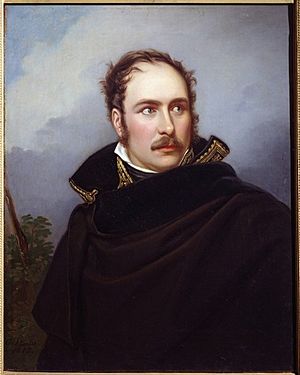
Portrait by Joseph Karl Stieler, 1815
|
|||||
| Viceroy of Italy | |||||
| Term | 5 June 1805 – 11 April 1814 | ||||
| Monarch | Napoleon I | ||||
| Duke of Leuchtenberg Prince of Eichstätt |
|||||
| Tenure | 14 November 1817 – 21 February 1824 | ||||
| Successor | Auguste de Beauharnais | ||||
| Born | 3 September 1781 Paris, Kingdom of France |
||||
| Died | 21 February 1824 (aged 42) Munich, Kingdom of Bavaria |
||||
| Burial | St. Michael's Church, Munich | ||||
| Spouse |
Princess Augusta of Bavaria
(m. 1806) |
||||
| Issue | Josephine, Queen of Sweden Eugénie, Princess of Hohenzollern-Hechingen Auguste, Prince Consort of Portugal Amélie, Empress of Brazil Théodolinde, Countess Wilhelm of Württemberg Princess Carolina Maximilian, 3rd Duke of Leuchtenberg |
||||
|
|||||
| House | Beauharnais | ||||
| Father | Alexandre de Beauharnais | ||||
| Mother | Joséphine de Beauharnais | ||||
| Religion | Roman Catholicism | ||||
| Signature | |||||
Eugène Rose de Beauharnais ([øʒɛn də boaʁnɛ]; 3 September 1781 – 21 February 1824) was an important French nobleman, leader, and military commander. He served during the French Revolutionary Wars and the Napoleonic Wars.
Eugène was the stepson of Napoleon Bonaparte. This happened because his mother, Joséphine de Beauharnais, married Napoleon. Later, Napoleon also adopted Eugène as his son. Eugène led the Army of Italy during the Napoleonic Wars. He was also the Viceroy (like a governor) of the Kingdom of Italy under Napoleon. Many historians believe he was one of Napoleon's most skilled relatives.
Contents
Early Life and Military Start
Eugène Rose de Beauharnais was born in Paris, France, on 3 September 1781. His family, the House of Beauharnais, came from the French colony of Martinique. His father, Viscount Alexandre de Beauharnais, was executed in 1794. This happened just before the end of a difficult time in France called the Reign of Terror.
Eugène started his military career when he was young. He served with General Lazare Hoche and fought in the War in the Vendée. His mother, Joséphine, arranged for him to return to Paris after she married Napoleon. Eugène then joined the 1st Hussar Regiment. He became an aide-de-camp (a personal assistant) to his stepfather, Napoleon. He served in Napoleon's campaigns in Italy from 1796 to 1797. In 1799, he also took part in the French campaign in Egypt and Syria. He was wounded during the Siege of Acre.
In 1799, Eugène was with Napoleon during the Coup of 18 Brumaire. This was when Napoleon took power in France. After Napoleon became the leader, Eugène was made captain of the Chasseurs à Cheval, a special guard unit. He fought bravely in the Battle of Marengo, even when many of his men were lost.
Eugène continued to rise through the ranks. In 1804, after Napoleon created the Empire, Eugène was promoted to brigade general. In 1805, he was given the important title of Arch-Chancellor of State.
Becoming Viceroy of Italy
As commander of the Imperial Guard, Eugène went to Milan before Napoleon's coronation. Napoleon was crowned King of Italy on 26 May 1805. Napoleon had first wanted his brother Joseph or his nephew Napoléon Charles to be King of Italy. But they both refused. So, Napoleon crowned himself. During the ceremony, Napoleon gave the royal ring and robe to Eugène. On 7 June 1805, Napoleon announced that Eugène would be the Viceroy of Italy. A Viceroy is like a governor who rules a country or province as the representative of a king or emperor.
Leading Armies
During the War of the Fifth Coalition in 1809, Eugène was put in charge of the Army of Italy. He had experienced generals like MacDonald helping him. In April 1809, he lost the Battle of Sacile against the Austrian army. However, Eugène's troops won the next battles at the Piave River in May and the Battle of Raab in June. After another battle, Napoleon called the Army of Italy to Austria. Eugène joined the main army and fought in the Battle of Wagram.
Napoleon thought about making Eugène the regent (a temporary ruler) of France during the Russian campaign. But he decided not to. During the Russian campaign, Eugène again commanded the Army of Italy. He fought in the Battle of Borodino and the Battle of Maloyaroslavets. After Napoleon and another general, Joachim Murat, left the retreating army, Eugène took command. He led the remaining soldiers back to Germany in 1813.
During the German campaign of 1813, Eugène fought in the Battle of Lützen. Napoleon then sent him back to Italy. There, Eugène organized the defense against the Austrians. He held out until Napoleon gave up his throne in 1814.
Life After Napoleon
After Napoleon's fall in 1814, Eugène moved to Munich. This was at the request of his father-in-law, King Maximilian I Joseph of Bavaria. He soon returned to Paris when his mother died. He was welcomed by the new French king, Louis XVIII, and the Russian emperor, Alexander I of Russia. Eugène decided to stop his political activities. He went back to his wife's family in Bavaria. Because of this, he stayed neutral when Napoleon returned to power for a short time (the Hundred Days).
As the Duke of Leuchtenberg, Eugène spent his final years in Munich. He managed his properties and expanded his art collection. He also helped people who were in trouble during the time when the old French monarchy was restored. He also tried to get better treatment for Napoleon, who was imprisoned on Saint-Helena. In 1822, Eugène's health began to get worse. He died on 21 February 1824 in Munich, at the age of 42.
Family and Titles
On 14 June 1804, Eugène officially became a member of the imperial family. He was known as His Imperial Highness, French Prince Eugène de Beauharnais. On 5 June 1805, the Emperor added the title Viceroy of Italy to his name.
Napoleon adopted Eugène on 12 January 1806. However, Eugène could not become the next emperor of France. On 16 February 1806, Eugène was named the likely heir to the Kingdom of Italy. On 20 December 1807, he was given the title of Prince de Venise ("Prince of Venice"). This title was created when the Venetian Province became part of Napoleon's Kingdom of Italy.
In 1810, Napoleon helped Eugène become the heir to the Grand Duchy of Frankfurt. This was a German state. The ruler of Frankfurt gave up his title in 1813. Eugène then became the nominal (in name only) grand duke until the allied armies took over Frankfurt.
Another important title he held was Archchancellor of State of the Empire of France. His name, BEAUHARNAIS, is carved on Column 24 of the Southern Pillar of the Arc du Triomphe in Paris.
Marriage and Children
On 14 January 1806, Eugène married Princess Augusta Amalia Ludovika Georgia of Bavaria (1788–1851). She was the eldest daughter of King Maximilian I Joseph of Bavaria, who was an ally of Napoleon. Even though this was a political marriage, Eugène and Augusta had a very happy life together. On 14 November 1817, his father-in-law made him Duke of Leuchtenberg and Prince of Eichstätt.
Eugène and Augusta had seven children:
- Princess Joséphine Maximiliane Eugénie Napoléonne de Beauharnais (1807–1876); she became the Queen of Sweden.
- Princess Eugénie Hortense Auguste de Beauharnais (1808–1847); she married Friedrich, Prince of Hohenzollern-Hechingen.
- Prince Auguste Charles Eugène Napoléon de Beauharnais, 2nd Duke of Leuchtenberg (1810–1835); he married Queen Maria II of Portugal. They did not have children.
- Princess Amélie Auguste Eugénie Napoléone de Beauharnais (1812–1873); she became the Empress of Brazil.
- Princess Theodelinde Louise Eugénie Auguste Napoléone de Beauharnais (1814–1857); she married Wilhelm, 1st Duke of Urach.
- Princess Carolina Clotilde de Beauharnais (born and died in 1816).
- Prince Maximilian Josèphe Eugène Auguste Napoléon de Beauharnais (1817–1852); he married Grand Duchess Maria Nikolaievna of Russia.
Battle Record
Here are some of the battles Eugène de Beauharnais fought in:
- Battle of Sacile (1809) - Defeat
- Battle of Caldiero (1809) - Defeat
- Battle of Piave River (1809) - Victory
- Battle of Tarvis (1809) - Victory
- Battle of Raab (1809) - Victory
- Battle of Borodino (1812) - Victory
- Battle of Maloyaroslavets (1812) - Indecisive (no clear winner)
- Battle of Lützen (1813) - Victory
- Battle of Caldiero (1813) - Victory
- Battle of the Mincio River (1814) - Indecisive
Heraldry
See also
 In Spanish: Eugène de Beauharnais para niños
In Spanish: Eugène de Beauharnais para niños


